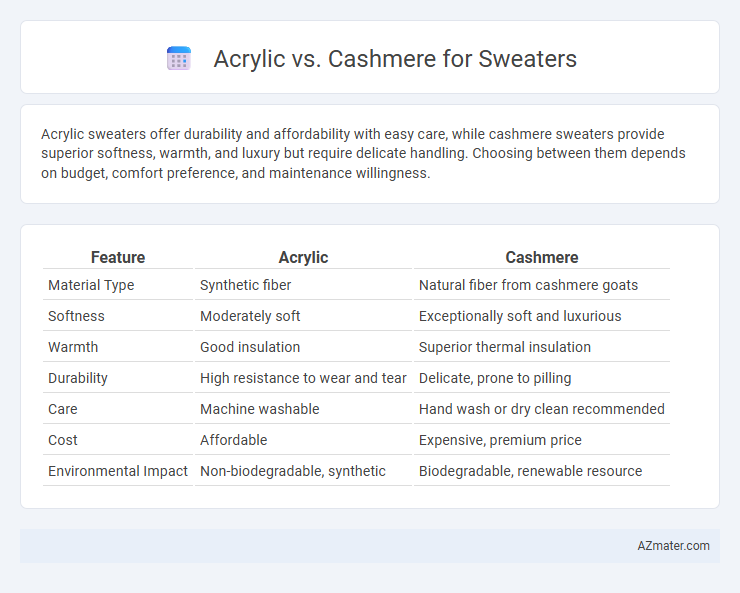Acrylic sweaters offer durability and affordability with easy care, while cashmere sweaters provide superior softness, warmth, and luxury but require delicate handling. Choosing between them depends on budget, comfort preference, and maintenance willingness.
Table of Comparison
| Feature | Acrylic | Cashmere |
|---|---|---|
| Material Type | Synthetic fiber | Natural fiber from cashmere goats |
| Softness | Moderately soft | Exceptionally soft and luxurious |
| Warmth | Good insulation | Superior thermal insulation |
| Durability | High resistance to wear and tear | Delicate, prone to pilling |
| Care | Machine washable | Hand wash or dry clean recommended |
| Cost | Affordable | Expensive, premium price |
| Environmental Impact | Non-biodegradable, synthetic | Biodegradable, renewable resource |
Introduction to Acrylic and Cashmere Sweaters
Acrylic sweaters offer an affordable, durable, and lightweight alternative to natural fibers, known for their resistance to wrinkles and ease of care. Cashmere sweaters, made from the soft undercoat of cashmere goats, provide exceptional warmth, luxurious softness, and excellent insulation properties. Choosing between acrylic and cashmere depends on budget, desired comfort, and maintenance preferences.
Material Origins and Production Processes
Acrylic sweaters are made from synthetic fibers derived from polyacrylonitrile, a petroleum-based polymer produced through a chemical polymerization process that mimics natural wool properties. Cashmere sweaters use natural fibers obtained from the undercoat of cashmere goats, primarily raised in regions like Mongolia and China, with production involving hand-combing or shearing to harvest fine, soft fibers. The synthetic origin of acrylic allows for mass production with consistent quality, while cashmere's artisanal harvesting ensures luxury softness but requires more time-intensive, sustainable farming practices.
Texture and Feel: Comfort Comparisons
Acrylic sweaters offer a smooth, lightweight texture that mimics wool but can sometimes feel less breathable and trap heat, leading to potential discomfort during extended wear. Cashmere sweaters boast an exceptionally soft, luxurious feel with natural insulation properties that provide warmth while remaining breathable and gentle on sensitive skin. The comfort of cashmere surpasses acrylic in softness and moisture management, making it ideal for those prioritizing premium texture and cozy wearability.
Warmth and Insulation Properties
Cashmere sweaters provide superior warmth and insulation due to their fine, natural fibers that trap heat effectively while remaining lightweight and breathable. Acrylic sweaters offer decent insulation but tend to be less efficient at retaining body heat compared to cashmere, often resulting in a bulkier feel. The moisture-wicking ability of cashmere further enhances its thermal regulation, making it a premium choice for cold weather.
Durability and Longevity
Acrylic sweaters offer high durability due to their resistance to moths, mildew, and chemicals, making them less prone to wear and tear over time compared to cashmere. Cashmere, while prized for its softness and warmth, tends to be more delicate and requires careful maintenance to retain its longevity, as it can pill and lose shape with frequent use. Choosing acrylic ensures longer-lasting durability in everyday wear, whereas cashmere excels in luxurious comfort but demands gentle handling to maintain its lifespan.
Price Differences and Affordability
Acrylic sweaters are significantly more affordable than cashmere, often priced at a fraction of the cost, making them accessible for budget-conscious shoppers. Cashmere, derived from the soft undercoat of cashmere goats, commands a premium due to its luxurious softness and insulation properties. While cashmere offers superior warmth and durability, acrylic provides a cost-effective alternative with easy care and decent comfort, ideal for everyday wear without compromising affordability.
Care and Maintenance Requirements
Acrylic sweaters require simple care with machine washing on a gentle cycle and low heat drying, making them low-maintenance and resistant to shrinking or fading. Cashmere sweaters need more delicate handling, including hand washing with mild detergent or dry cleaning, and must be dried flat to preserve softness and shape. Proper storage, such as folding and using breathable bags, prevents cashmere from pilling and moth damage, whereas acrylic is generally more durable in daily wear scenarios.
Environmental Impact and Sustainability
Acrylic sweaters, made from synthetic fibers derived from petroleum, have a significant environmental impact due to non-renewable resource consumption and microplastic pollution in water systems during washing. Cashmere, sourced from the undercoat of cashmere goats, is a natural fiber but faces sustainability challenges related to overgrazing and land degradation in production regions such as Mongolia and China. Opting for sustainably sourced cashmere with certifications and responsible grazing practices reduces environmental damage compared to acrylic, which lacks biodegradability and contributes to long-term ecological harm.
Style and Versatility Options
Acrylic sweaters offer vibrant color retention and easy care, making them ideal for trendy, budget-friendly styles and layering options suitable for everyday wear. Cashmere provides a luxurious texture with superior warmth and drape, elevating classic and sophisticated outfits perfect for both casual and formal occasions. Versatility in acrylic allows bold fashion experimentation, while cashmere maintains timeless elegance across diverse wardrobe combinations.
Choosing the Right Sweater for Your Needs
Acrylic sweaters offer affordability, durability, and easy maintenance, making them ideal for everyday wear and allergy-sensitive individuals. Cashmere sweaters provide superior softness, warmth, and breathability, perfect for high-quality, luxurious comfort in colder climates. Selecting between acrylic and cashmere depends on your budget, sensitivity to fibers, and desired warmth and texture.

Infographic: Acrylic vs Cashmere for Sweater
 azmater.com
azmater.com